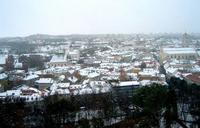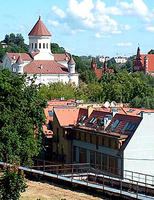You are in: Europe -> Lithuania -> Vilnius Historic Centre, and traditional search or Image Gallery will yield results of this site only
Vilnius Historic Centre
| Site number: | 541 |
|
| Type of site: | Cultural | |
| Date: | 13-18 centuries | |
| Date of Inscription: | 1994 | |
| Location: | Europe, Lithuania, City of Vilnius | |
Up to 75 images are shown here. Click on each for more details or on Image Gallery for more images.
Six official UN languages:
Arabic,
Chinese,
English,
French,
Russian,
Spanish
Other languages: Belarusian, Bulgarian, Catalan, Chuvash, Croatian, Czech, Danish, Dutch, Esperanto, Estonian, Finnish, Galician, German, Greek, Hebrew, Hungarian, Italian, Japanese, Korean, Latin, Latvian, Lithuanian, Lombard, Norwegian-bokmål, Norwegian-nynorsk, Polish, Portuguese, Romanian, Samogitian, Serbian, Slovak, Thai, Turkish, Ukrainian
Other languages: Belarusian, Bulgarian, Catalan, Chuvash, Croatian, Czech, Danish, Dutch, Esperanto, Estonian, Finnish, Galician, German, Greek, Hebrew, Hungarian, Italian, Japanese, Korean, Latin, Latvian, Lithuanian, Lombard, Norwegian-bokmål, Norwegian-nynorsk, Polish, Portuguese, Romanian, Samogitian, Serbian, Slovak, Thai, Turkish, Ukrainian
| Description: | From the 13th to the late 18th century Vilnius was the political centre of the Grand Duchy of Lithuania. Throughout its years the city has had a deep influence on much of Eastern Europe’s cultural and architectural development. The site has preserved a remarkable set of Gothic, Renaissance, Baroque and classical buildings and it still sits within its medieval layout and natural setting despite various invasions and even partial destruction. --WHMNet paraphrase from the description at WHC Site, where additional information is available. | |
| The Old Town of Vilnius (Lithuanian: Vilniaus senamiestis), one of the largest surviving medieval old towns in Eastern Europe, has an area of 3.59 square kilometres (887 acres). It encompasses 74 quarters, with 70 streets and lanes numbering 1487 buildings with a total floor area of 1,497,000 square meters. The oldest part of the Lithuanian capital of Vilnius, it has developed over the course of many centuries, and has been shaped by the city's history and a constantly changing cultural influence. It is a place where some of Europe's greatest architectural styles - gothic, renaissance, baroque and neoclassical - stand side by side and complement each other. Pilies Street is the Old Town's main artery and the hub of café and street market life. The main street of Vilnius, Gediminas Avenue, is partially located in the Old Town. The central squares in the Old Town are the Cathedral Square and the Town Hall Square. One of the most elaborate architectural complexes is the Vilnius University Architectural Ensemble, which occupies the entire section of the Old Town and has 13 courtyards. It was selected to represent Lithuania in the Mini-Europe Park in Brussels. In 1994 the Vilnius' Old Town was included in the UNESCO World Heritage List (No. 541) in recognition of its universal value and originality. --Wikipedia. Text is available under the Creative Commons Attribution-ShareAlike License. | ||
| Source: | http://whc.unesco.org/en/list/541 | |
| Reference: | 1. UNESCO World Heritage Center, Site Page. | |






























